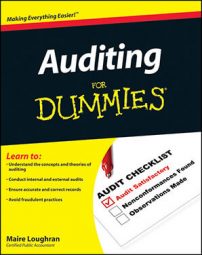As you perform your audit, you have to determine how important a contingent liability is to the audit. A contingent liability can come in three categories, and the category it falls into gives you guidance on whether it needs to be disclosed in the notes to the financial statements:
Probable: This category means that the future event will likely occur. For example, the IRS examination is winding down, and because of the volume of tax code and court cases the government has provided to date supporting its position, your client is fairly certain that additional tax will be assessed.
Reasonably possible: The chance of the future event happening is more than remote but less than probable. For example, your audit client is involved in a lawsuit, but at this point in the proceedings, not enough evidence has been presented in court to rule out a judgment for or against the company.
Remote: The chance of the future event taking place is remote. Consider the example of your client selling a faulty product and having significant warranty claims as a result. If your client has isolated the bad product, recalled it, and settled the related warranty claims, chances are slim that it will need to deal with similar warranty issues on that product in the future.
How do these categories help you make decisions regarding financial statement disclosure? Here are the rules:
If a contingent liability is probable and the amount of loss that could be sustained is reasonably estimated, the loss is shown on the financial statements by reducing net income and increasing liabilities. For example, if your client knows that the warranties on the faulty product are going to cost in the neighborhood of $300,000, net income is reduced by a warranty expense in that amount, and the balance sheet liability account accrued warranties is increased as well.
If the future event is reasonably possible, or if it’s probable but the client can’t reasonably estimate the amount of losses, a note is made disclosing this fact in the financial statements. Here’s an example of a disclosure of pending litigation:
On April 30, 20XX, a class action complaint was filed by a shareholder against the Company in the U.S. District Court. At this time, it’s not possible to predict the potential financial impact on the Company of an adverse decision.
If the contingent liability is deemed to be remote, it’s neither disclosed in notes to the financial statements nor used to adjust the financial statements.
So how do you make a judgment call on which category a contingent liability falls into? This situation may require discussion with outside experts and definitely requires the application of your professional judgment. As a new auditor, you need to discuss this situation with your audit team leader. Some of the contingent liabilities you’ll see will be addressed in prior years’ files for continuing clients. After all, lawsuits can drag on forever. But whether the contingent liability is old or new, talk your team leader. Facts may have changed. A contingent liability that was remote in prior years may now be probable.

